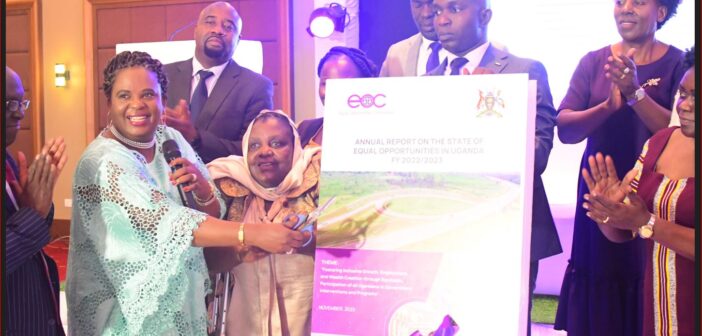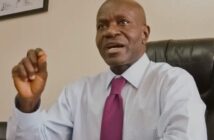A report released by the Equal Opportunities Commission has highlighted the regional disparities in employment access within the public service sector in Uganda.
The report reveals that only 39% of Ugandan youth have access to public service employment opportunities.
Notably, the Western region boasts the highest number of employees among all regions.
Presenting the 10th annual report on the state of equal opportunities in Uganda for the financial year 2022/2023, Safia Nalule Juuko, Chairperson of the Equal Opportunities Commission, emphasised the theme for the year: “Fostering inclusive growth, employment, and wealth creation through equitable participation of all Ugandans in government interventions and programs.”
The report stresses the importance of ensuring compliance with gender and equity requirements in government planning and budgeting.
The report examines the progress, challenges, and opportunities related to equal access and participation in various aspects of life in Uganda.
It highlights the pivotal role of the Equal Opportunities Commission in realising Uganda’s transformation agenda, considering the country’s diverse strengths and challenges.
Based on data from 30 sampled government MDAs (Ministries, Departments, and Agencies), the report notes that the western region has the highest percentage of individuals accessing employment opportunities in public service, standing at 36%. The central region follows at 24%.
The report attributes the high level of government job access in these regions to factors such as a larger population of educated individuals, proximity to information, access to national data, and availability of resources compared to other regions.
Regarding top management positions, the report reveals that males dominate, occupying 60% of such positions on average across the sampled agencies.
The Western region shows the highest percentage of employees in top positions at 40%, followed by the Central region at 26%.
In contrast, the Northern and Eastern regions have the lowest percentages at 12% and 21%, respectively. Additionally, the Sebei sub-region lacks any employees in top management positions across all sampled institutions.
In the political arena, the report unveils that women represent 45.8% of Uganda’s Cabinet, indicating a steady increase over the years.
While special interest groups like youth and persons with disabilities have representation, ethnic minorities remain unrepresented, hindering their access to national services and resources.
The report also highlights regional disparities in parliamentary representation.
Further analysis of the Cabinet composition reveals that out of the 30 Cabinet Ministers, 12 are female, accounting for 40% representation.
Among the 50 State Ministers, 24 are female, accounting for 48% representation. The proportion of women in the cabinet has more than tripled from 14.7% in 2006 to 45.8% in 2021/2025.
The report further exposes gender disparities in education, with female students facing limited access to programs compared to their male counterparts.
The Northern region particularly struggles, with only 12.5% of student beneficiaries since the program’s inception.
Karamoja sub-region experiences the least proportion of students accessing the University Students Loan Scheme, with only 1.7% beneficiaries out of the total 13,405 students in the program.
Notably, Amudat district has had only one beneficiary since the start of the university loan scheme program.
Additionally, only 0.7% of the beneficiaries (94 students) are individuals with disabilities, while young people from ethnic minority groups have not benefited from the loan scheme.
Uganda’s education system exhibits mixed performance across regions and genders, with certain areas lagging behind.
The report underscores the importance of equal access to education and the necessity of establishing more secondary schools in underserved regions.
The report also draws attention to the underfunding of Uganda’s health sector, which heavily relies on private sources of financing, particularly out-of-pocket spending.
Public spending on health, at 7.9% of total government expenditure, falls significantly below the 15% Abuja target committed to by the Ugandan government. For instance, the Bukedi sub-region, comprising seven districts, lacks a regional referral hospital.
Out of the 52 government general hospitals in Uganda, approximately 60% of the country’s districts lack such facilities.
Moreover, four districts have neither a government hospital nor a health centre IV, namely Agago, Kalaki, Namisindwa, and Napak.
Additionally, 172 sub-counties lack health centre IIIs, causing detrimental effects on the vulnerable and marginalized groups’ ability to access healthcare.
The report highlights the chronic shortage of trained health workers, leading to overworking of available personnel.
Uganda faces an acute shortage of health workers and specialists across all types of health facilities, particularly at lower-level facilities.
Inadequate infrastructure, including health centre premises, emergency and referral response systems, and medical equipment, further compounds the challenges faced by lower-level health facilities in Uganda.
To address the inequalities and imbalances observed throughout the report, several recommendations are put forth.
These include increased funding, the construction of essential infrastructure, improved representation and participation of marginalized groups, and the promotion of equitable access to education and employment opportunities.
Nalule calls for concerted efforts from the government, civil society organizations, and other stakeholders to implement these recommendations and ensure inclusive growth and development for all Ugandans.



